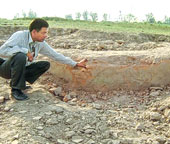
Lucknow, Dec. 30: A long-buried village, burnt down by the British in 1857, has finally got its due nearly 150 years after it lost its place on the country’s map.
An archaeology seminar that drew delegates from across the country and abroad was today told that Mahua Dabar — a village in modern-day Basti, Uttar Pradesh, where weavers from Bengal had migrated early in the 19th century — was indeed a textile hub before the British razed it to the ground.
The June 10 pogrom, at the height of countrywide unrest during India’s first war of independence, was in retaliation to the murder of some British officers by the villagers a week earlier.
Professor Anil Kumar, who presented a paper at the conference, said excavations at three trenches had thrown up “presence of mica” which was “used in those days for printing clothes”.
“Often, mica was used in those days … to hide a part of the design,” the paper said.
.N. Singh, a retired archaeologist from Madhya Pradesh who attended the three-day seminar at Lucknow University, said the findings had lessons for India.
“The evidences authenticate a turbulent history which has great lessons for India in its march to industrialisation,” Singh said.
Kumar, an associate professor in the university’s archaeology department, led the search for Mahua Dabar, which lies about 210km from Lucknow.
The excavations, in February-March this year, followed a nod from the Archaeological Survey of India after a panel of historians set up by the state government came out with a report in 2007 that said the village had once existed.
In the paper, Excavations at Mahua Dabar, Kumar said: “Evidences from three trenches excavated there included charred soil, burnt items of private homes, discovery of a well … and two outlets from the well…. These outlets were for getting fresh water from the well for dying and printing fabrics.”
He said the layer of soil recovered from the outlet indicate it was in use for discharging the wastewater after dying and printing fabrics. “The finding of the debris and the evidence of wastewater collection from the well show that water from the well was not used for drinking purposes.”
The weavers of Mahua Dabar had settled there after fleeing Bengal to escape a British crackdown at a time British textile industry was reaping the fruits of the industrial revolution and the head start given by its inventors.
“Although the killing of British officers preceded the pogrom, the vengeance with which a textile hub was destroyed might have had a lot to do with British interest in the same industry,” said veteran archaeologist Ashoke Singh.
Kumar told The Telegraph that written chronicles, “culled both from government and private sources”, had pointed out that the weavers who had migrated from Bengal had settled down in Mahua Dabar in the early 19th century.
The second-generation weavers, who had learnt their skills from their forefathers, helped the village grow into a textile hub, the paper said.
That was before the 1857 massacre.
The village was part of the district map of 1831, but since 1861, it has found no mention in government maps.
After the villagers fled, Mahua Dabar ceased to be a revenue village. All that existed was a small river, Manorama, a mosque and some mounds.
“A wall 30-35ft high, a stretch of land along that wall with traces of burnt articles and traces of burnt soil have been found from the excavation site, indicating the pogrom,” Kumar said.
The search for the wiped-out village was launched by a descendant of one of the weaver families. Mohammad Latif Ansari’s family had fled Mahua Dabar to first Lucknow and then to Mumbai.
Ansari, 62, started his search after getting hold of some family documents. He then contacted some of the other descendants of the weaver families scattered all over the country.
In 1993, he urged the state government to set up a committee of historians. In its 2007 report, the committee recommended that the area be excavated.
“The excavations have unearthed a chapter of history that links directly to contemporary history,” senior BHU archaeologist Bibha Tripathi said after the seminar ended.
This Article Reprinted from The Telegraph - India
